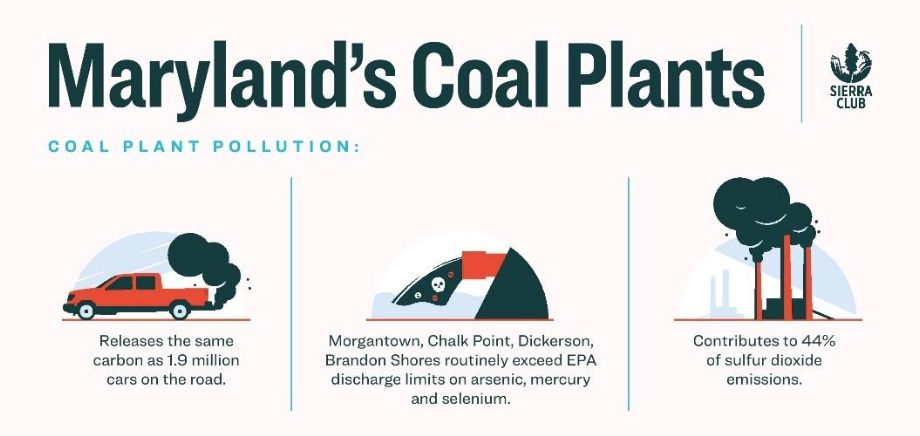It is clear that it is time for Maryland to prepare for, and undertake, the transition away from coal-fired power plants. In doing so, we must support impacted communities and workers in defining and implementing strategies which provide certainty for a transition timeline.
Maryland “Coal 101”
Coal is a 19th century technology which is a leading contributor to dangerous climate disruption, and is making our families and communities sick, leading to as many as 13,000 premature deaths every year and more than $100 billion in annual health costs. (1) Power plants which burn coal pump out toxic and dangerous pollution including lead, mercury, selenium, smog-forming nitrogen oxides, and acid-rain-causing sulfur pollution.
Here in Maryland, we still have six large coal-fired power plants contributing to public health problems, climate disruption, and other environmental degradation. Eighty-eight percent of Marylanders live in counties which do not meet clean air standards set by the Environmental Protection Agency for smog. Breathing smog is like getting a sunburn on your lungs and exacerbates respiratory issues like asthma – an illness which negatively impacts hundreds of thousands of Marylanders. (2)
Maryland’s Coal-Fired Power Plants by the Numbers

-
6 – Six coal plants in Maryland pumped out the same amount of climate pollution in 2017 as over 2,000,000 cars – that’s over 40% of the passenger vehicles on the road in Maryland.
-
5 – Five coal plants in Maryland were operating with expired water discharge permits in 2018.
-
4 – Four coal plants in Maryland were built during or before the Nixon presidency (two were built when Dwight Eisenhower was President!).
-
3 – Three coal plants in Maryland are operating without modern pollution controls for smog-forming nitrogen oxides.
-
2 – Two coal-fired power plants in Maryland are co-located on the same site, polluting the same community, in northern Anne Arundel County just south of the Baltimore City border.
-
1 – One of Maryland’s coal plants was deactivated in 2018.
Coal Transition and the Clean Energy Economy
-
Nation-wide (3)
-
Since 2010, 280 coal-fired power plants have been retired or announced their retirement plans.
-
In 2016, a new wind turbine rose every 2.4 hours in the U.S.
-
There are more than twice as many solar jobs as coal jobs in the U.S., including mining and power.
-
Over 98,000 megawatts of clean energy have been installed on our power grid.
-
Maryland
-
From 2011 to 2017, electricity generation from coal in Maryland has declined by nearly 60%.
-
Since 2012, two coal plants have been deactivated in Maryland.
-
In 2016, the General Assembly passed a bill that was eventually signed by Governor Hogan, requiring the state to reduce climate pollution 40% below 2006 levels by 2030.
-
Solar jobs in Maryland have grown to over 5,000. (4)
-
Initial offshore wind development approved in Maryland is expected to grow almost 9,700 jobs and nearly $74 million in state tax revenue over a 20-year period. (5)
-
The offshore wind projects expected online in the early part of the next decade are projected to produce approximately 43% more electricity than Maryland’s Dickerson, Chalk Point, and Wagner coal plants produced in 2017.
Coal Community Transition
In 2018, after witnessing the on-the-ground pollution impact and analyzing the economic trends, members of the Maryland Commission on Climate Change recommended that the state develop and implement a coal community transition plan to chart a just and responsible environmental and economic transition away from coal in Maryland’s electricity sector.
It is clear that it is time for Maryland to prepare for the transition away from coal-fired power plants. We must support impacted communities and workers in defining, creating, and implementing strategies which provide certainty for transition timelines. Communities with coal plants and coal industry workers must be a part of developing the strategies and programs that will launch them into the clean energy economy and ensure protection of families and their interests. These plans must allow impacted industry and union workers to have access to training programs and clean energy-related economic opportunities which provide good-paying, family-sustaining, union jobs.
Maryland is not alone in this moment in history, nor in this coal transition. Places like New York and Washington have developed and implemented coal community transition plans, and initiatives are moving forward in many other states like Montana and Colorado. Under the 2017 Assistance to Coal Communities initiative, the federal US Economic Development Administration has funded projects to protect and support historic coal communities as our energy systems shift to cleaner alternatives. We must have Maryland lead on this issue and develop a plan to provide communities and our workforce with certainty and specificity on the transition away from coal.
Our reliance on coal-powered electricity is on a steep decline, and while this trend eases environmental injustices and pushes back against the historic public health harms and dangerous effects of climate change, we must recognize and prepare for the potential near-term economic impacts for fossil fuel communities. Maryland needs a plan to responsibly guide us off of coal in the next decade and ensure our workers and impacted communities are making decisions about how to thrive in the clean energy economy.
For info on our 2019 Legislative Efforts click here.
1 - http://www.catf.us/wp-content/uploads/2010/09/CATF_Pub_TheTollFromCoal.pdf
2 - https://www.cdc.gov/asthma/stateprofiles/Asthma_in_MD.pdf
3 - https://content.sierraclub.org/coal/about-the-campaign
4 - https://www.seia.org/state-solar-policy/maryland-solar
5 - https://www.psc.state.md.us/wp-content/uploads/PSC-Awards-ORECs-to-US-Wind-Skipjack.pdf